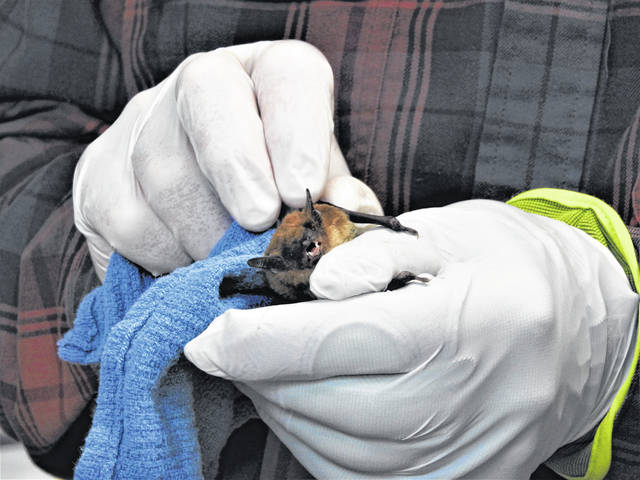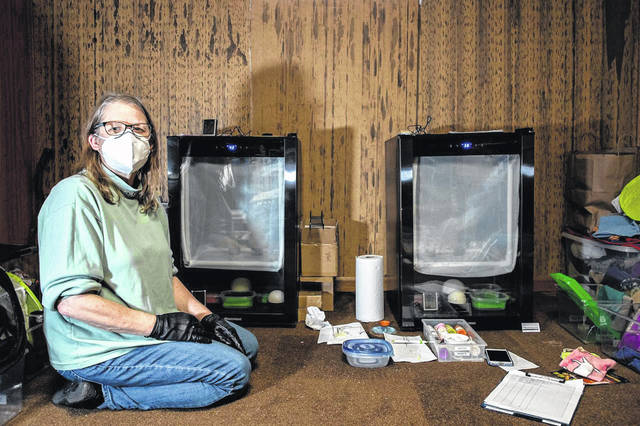

COLUMBUS, Ohio – After five months of caring for 27 big brown bats hibernating in two wine coolers in her basement, Ann Wookey cheered as they took flight back to the wild May 1 in a grassy field in northeast Columbus.
As a long-time volunteer for Ohio Wildlife Center, the state’s largest wildlife rehabilitation nonprofit organization, Wookey accepted the assignment last fall to work with the center’s team to overwinter bats at her home by putting them into artificial hibernation inside the wine coolers for the winter. The Ohio Wildlife Center’s Wildlife Hospital, located at 2661 Billingsley Road in Columbus, typically receives between 30 to 40 bats each year that miss their migration window in the fall due to injuries, or are discovered hibernating inside people’s homes in chimneys or attics.
Creating a simulated hibernation site within commercial wine coolers mimics the natural conditions that bats have in the wild with controlled temperatures and humidity levels, according to Stormy Gibson, assistant executive director of the Ohio Wildlife Center, located at 6131 Cook Road in Powell.
“This approach ensures their health and safety during many months of hibernation until they can be released in the spring when food sources are more available to them,” she said. This is the first year the center has carried out this plan, which was funded through a grant from the Barbara and Bill Bonner Family Foundation.
Big brown bats are one of the most common bats in Ohio and one of the species of bats that hibernate in the winter from November to March. Wookey modified the wine coolers by removing the shelves and creating a cave-like setting with special netting and soft sided pockets so the bats could hang upside down as they would within a cave or rock crevice. The coolers were monitored for the specific temperature and humidity settings required to keep the bats in hibernation. The 17 males and 10 females were kept in separate coolers to prevent any breeding activity.
“Bats are very social, and females want to be with other females during hibernation,” Wookey said. “In nature they do hibernate in groups, so we followed that pattern,” she said.
Each bat was assessed at the Wildlife Hospital prior to joining the hibernating groups that initially were placed in the coolers in mid-December. They had full veterinary exams, were tested for COVID-19, and quarantined for two weeks. Weight and health are critical indicators for the simulated hibernation, Gibson noted, and each big brown bat had to meet a specific weight metric and be free of any injury or illness.
Once placed in hibernation, the bats were monitored daily. In February, they were each examined and weighed again to ensure their weight was within safe limits before being returned to the cooler until April.
“Big brown bats in the wild hibernate to survive periods of cold and a lack of food from insects during the winter months,” Gibson said. “Their heart rate in hibernation drops to 40 to 80 beats per minute compared to the normal range of 250 to 450 beats a minute,” she said.
Wookey, who is a keeper at the Columbus Zoo and Aquarium, started volunteering to do bat care for Ohio Wildlife Center six years ago.
“I love bats,” she said, “and I had the space at home to do this since I have done home care for bats for many years.” Wookey is authorized to carry out home care for the bats by being a sub-permittee of the Ohio Wildlife Center’s rehabilitation permit granted by the Ohio Division of Wildlife. She also is vaccinated against rabies, which is required by the center for volunteers who work with rabies vector species.
“The simulated hibernation process is becoming more common in wildlife rehabilitation as it allows us to care for more bats in an environment that is closer to their natural behaviors,” she added.
According to Gibson, “The big brown bats were the right species to pioneer this at the center because we receive so many at the hospital that we have to overwinter for many months and they are natural hibernators.”
Gibson noted that bats play an important role in pest control, pollinating plants and dispersing seeds. “They are the only mammals that fly and are important animals in ecosystems across the globe.”
Prior to their release, the bats were slowly acclimated to warmer temperatures. Each bat was weighed, given food and water, and received a veterinary exam at the Wildlife Hospital to be cleared for take off.
About Ohio Wildlife Center
Ohio Wildlife Center is dedicated to fostering awareness and appreciation of Ohio’s native wildlife through rehabilitation, education and wildlife health studies. The center’s Wildlife Hospital in Columbus is the largest in Ohio, and 8,105 animals were assessed and treated at the hospital in 2020 from 67 counties in the state.



